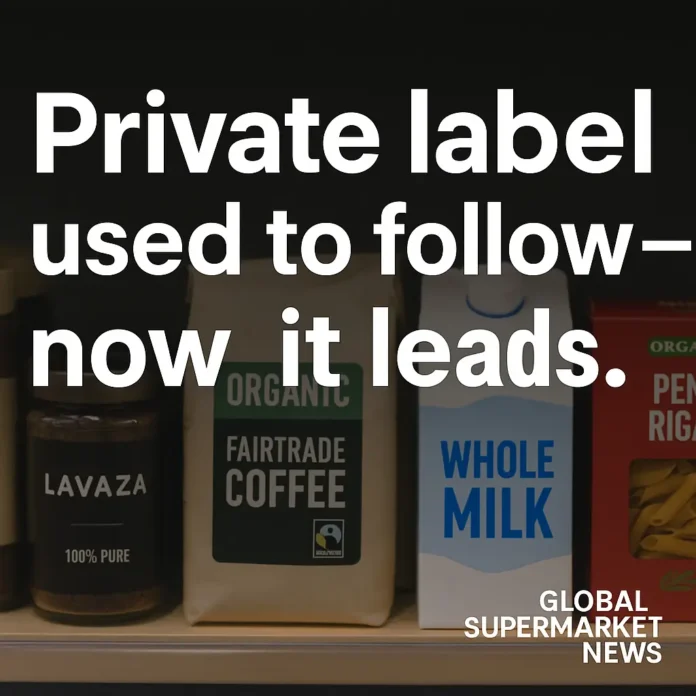Private label used to mean the cheaper option—the no-frills version, the fallback. In 2025, it means something else entirely: trust, taste, transparency, and brand leadership.
From Canada to Spain, supermarkets are no longer treating their own brands as second-tier. They’re investing in them, innovating through them, and—more importantly—winning with them. Because today, owning the product means owning the relationship.
A Market That’s Quietly Shifted
You won’t always see headlines about it, but the numbers don’t lie. Private label sales are rising faster than national brands across nearly every category. In the U.S. alone, supermarket-owned brands now account for over 23% of grocery unit sales. In parts of Europe, it’s over 40%.
Consumers aren’t just tolerating private label—they’re choosing it. Not only because it’s cheaper, but because it’s getting better. Cleaner ingredients. Better design. More transparency. And often, more relevance.
This shift isn’t temporary. It’s structural. And the smartest retailers are treating it that way.
What Supermarkets Are Getting Right
1. Multi-tier brand architecture
Retailers aren’t relying on one generic brand anymore. Most now operate three distinct tiers:
- A value tier for price-sensitive shoppers
- A core range that meets everyday needs
- A premium line that competes directly with leading brands
Tesco, Carrefour, Kroger, and Target have mastered this structure. Each tier has its own voice, pricing, and packaging style. And that clarity helps shoppers trust the quality at every level.
2. Packaging that earns attention
The design language of private label has evolved. Gone are the plain white boxes. In their place: soft-touch finishes, bold colours, eco icons, and clear nutrition callouts. Brands like Waitrose and M&S have blurred the line between own brand and luxury label. Even discounters like Lidl are investing in matte-finished wine labels and artisanal bread bags.
3. Faster, smarter innovation
When you own the product, you can move fast. Retailers are now developing in-house products in weeks—not months. Walmart’s “Bettergoods” line rolled out 300 new SKUs in less than a year. Kroger is using data from loyalty cards to spot gaps and launch new items. These are not copycat products—they’re leading-edge.
4. Stronger clean-label positioning
Sam’s Club reformulated over 500 Member’s Mark items to remove 40+ artificial ingredients. Aldi eliminated synthetic colours and MSG from hundreds of lines. These aren’t stunts—they’re long-term plays to win trust. And they’re working. Surveys show a rising number of consumers trust private label more than national brands in categories like dairy, baby food, and pantry staples.
5. Specialty and wellness-first ranges
From vegan sausages to protein-packed cereal bars, private label is now leading in wellness. Lidl’s Vemondo, Target’s Good & Gather, and Carrefour Bio all show how own-brand can outpace traditional suppliers when it comes to lifestyle trends.
Where Private Label Still Falls Short
Fresh categories aren’t telling stories
While shelf-stable and frozen aisles are thriving, produce and bakery often lag. There’s little branding, no storytelling, and not enough differentiation. That’s a missed opportunity. Fresh food is emotional—supermarkets need to tap into that.
E-commerce content is still behind
In-store, private label looks premium. Online? Too many listings lack detail. Low-res photos. No reviews. Generic copy. With online grocery becoming more common, that disconnect is becoming a liability.
Too many sub-brands create confusion
Some retailers launch a new sub-brand every quarter. The result? Shoppers don’t know what’s what. Clearer architecture—one tier for value, one for core, one for premium—is easier to navigate and builds long-term trust.
Real Brand Insights: What Leading Retailers Are Saying
“Our goal is to make Member’s Mark the most trusted brand on our shelves. And that means listening to our members, reformulating where we need to, and never compromising on quality.”
— Megan Crozier, Chief Merchant, Sam’s Club
“We treat our private labels the same way FMCG brands treat theirs. Consumer research, packaging focus, taste testing, feedback loops. It’s not just about filling shelf space—it’s about building brands.”
— Private Label Director, European Grocery Chain
“With Bettergoods, we weren’t chasing the market—we were leading it. These products are trend-forward, globally inspired, and wellness-focused. That’s what shoppers want.”
— Walmart Merchandising Team, U.S.
What Supermarkets Need to Do Next
- Close the fresh gap
Bring branding, design, and storytelling into produce, meat, deli, and bakery. Show sourcing stories. Highlight local growers. Make it feel curated. - Fix online presentation
Every product should have high-quality images, full descriptions, allergy callouts, and reviews. Treat every digital listing like a mini billboard. - Simplify the brand family
Avoid fragmentation. Fewer sub-brands, more clarity. One value line. One natural line. One indulgent line. - Invest in storytelling
Don’t just say “100% Arabica.” Say where it’s grown, who picked it, and why it matters. That’s what makes people care—and come back. - Let the data drive new products
Retailers are sitting on gold: real-time data. Use it to spot gaps and act quickly. Launch limited-time items. Test flavours. Iterate. Learn. Repeat.
Final Thought: Private Label Is Retail’s Quiet Superpower
Supermarkets don’t need to ask permission. They don’t need to buy shelf space. They already have it. Private label lets them build the product, price it competitively, market it authentically, and keep the margin.
And in 2025, the gap is closing.
National brands are still strong—but they’re no longer untouchable. Store brands have caught up. In many cases, they’ve overtaken.
Because the new question isn’t “is this as good as a brand?”
It’s: “Why would I pay more when this is better?”
And that’s a question private label is ready to answer.



